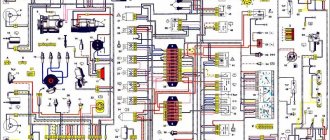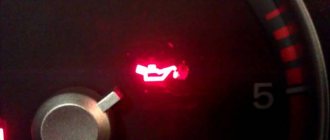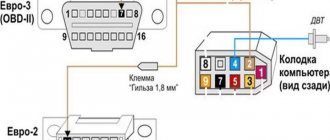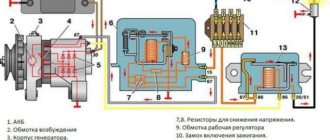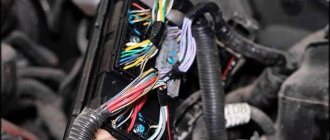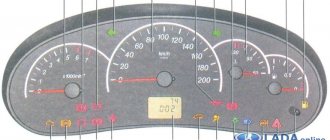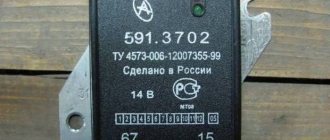Last week, out of the blue, the turn signal fuse blew out. The reason was absolutely not clear. Everything seems to be in place, KoZa is nowhere to be seen, and there are no wires with signs of melting. But the fact is the fact, the fuse has blown. I took a new one, installed it, and drove on.
Yesterday evening I came home, started parking in a yard filled with cars and suddenly “smelled something fried.” In addition, for some reason the turn signal light came on. It just caught fire and didn’t want to blink. I turned off the turn signals, pressed the hazard warning button - the result was the same. The light on the dash is on, but the outside lights are silent. But the arming and disarming indication works, the lamps blink. I went home, had dinner, read Murzilka, websites, forums, understand the reasons and look for solutions.
The time on the clock is 22:00. All the information collected and the logic of thinking led to the fact that the turn signal relay was covered with a copper basin. I went to DoubleGIS to look for a store that was open at that time. I found it on Mendileev/Krasnoyarsk. I went on foot because I didn’t want to drive without turn signals, even taking into account the minimal traffic on the road.
I come to the store, ask for a relay for the injector seven, and they answer me - Have you seen your relay? so six or five contacts? I went online again to find the markings. Everywhere it says that there should be a relay 231.3747. The seller gave 23.3747. I bought this relay for 110 rubles and went back.
It's midnight, and tomorrow I'll be driving again. A car is at the entrance, a lantern above the entrance illuminates the yard. A crazy thought flashed through my mind that people in gray-blue clothes who periodically drove UAZs through our yard would receive me without really understanding what and how.
I took the tool and reached under the dashboard.
In general, I took out the tidy, took out the relay and then went a little crazy. The relay in the car is four-pin and marked 494.3747.
There was nothing to do, I connected the purchased five-pin relay in the hope that it would work. And it works! I put everything back together, went home, disassembled the relay and... no words
Turn signals are designed to inform other road users about an upcoming maneuver. If they malfunction, the likelihood of an accident during maneuvering increases greatly. The most common cause of such a breakdown is a non-functioning VAZ 2107 turn relay. Traffic regulations prohibit operating a car with faulty light signals, so if such a malfunction is detected, it must be eliminated as soon as possible. This work can be performed by service station specialists.
Turn relay VAZ 2107
Unlike other lighting devices, the direction indicators operate intermittently and flash. A special device is responsible for the operation of the indicators - the VAZ 2107 turn signal relay. In addition to ensuring the blinking of the lamps, the relay performs a signaling function. It notifies you of the operation of the turn signals with audible signals - clicks.
At first, a thermal relay was installed on VAZ cars, in which the contacts were closed (opened) by a nichrome string, which heated and cooled due to the current passing through it. In later models, which include the “seven,” a relay with an electronic circuit and an electromagnet is used. The blinking frequency of the direction indicator lamps is determined by the settings of the electronic circuit. This design has fewer moving parts and contacts, and is therefore more reliable.
The device also performs the function of a VAZ 2107 emergency flasher relay, causing the lamps to flash when the hazard lights are turned on.
Pin type fuses
F1 (10A)
- Heater motor
- Reversing lamps
- Rear window heating indicator
- Rear window heating relay (winding)
F2 ( 10A)
- Windshield wiper and washer motor
- Motor for headlight cleaner and washer
- Windshield wiper relay
- Headlight cleaner and washer relay
F3 (10A)
F4 (10A)
F5 (20A)
- Rear window heating element and heating relay
F6 (10A)
- Cigarette lighter
- Socket for portable lamp
- Watch
F7 (20A)
- Sound signals
- Signal relay
- Radiator cooling fan relay (contacts)
- Radiator cooling fan motor
F8 (10A)
- Hazard warning switch with warning lamp
- Relay-breaker for direction indicators and hazard warning lights
- Turn signal indicator (in hazard warning mode)
- Direction indicators (in hazard warning mode)
F9 (10A)
- Generator voltage regulator
- Rear fog lamps and their indicator
F10 (10A)
- Turn signals (in turn signal mode)
- Turn signal interrupter relay
- Turn signal indicator
- Pneumatic valve control system
- Tachometer
- Fuel gauge
- Fuel reserve indicator
- Parking brake indicator
- Insufficient oil pressure indicator in the engine lubrication system
- Coolant temperature gauge
- Voltmeter
- Emergency indicator of the working brake system
- Battery charge indicator
- Carburetor choke indicator
- Electric fan relay (winding)
- Electric fan thermal switch
- Generator excitation winding (generator 37.3701)
F11 (10A)
- Interior lighting
- Brake light bulbs
- Luggage compartment lamp
F12 (10A)
- High beam headlights (right headlight)
- Windshield wiper and headlight wash relay (relay coil)
F13 (10A)
- High beam headlights (left headlight)
- High beam indicator
F14 (10A)
- Front side light (left headlight)
- Tail light (right light)
- License plate lights
- Engine compartment lamp
- Side light indicator
F15 (10A)
- Front marker light (right headlight)
- Tail light (left light)
- Cigarette lighter lamp
- Instrument lighting lamp
- Glove compartment lamp
- Clock (lighting lamp)
F16 (10A)
- Low beam headlights (right headlight)
- Windshield wiper and headlight wash relay (relay coil)
F17 (10A)
- Low beam headlights (left block headlight)
F18
F19
F20
F21
Malfunctions of turn signals VAZ 2107
The main symptom of a malfunction is non-functioning direction indicators. However, the reason may not be only the relay. There are several possible breakdowns:
- The turn signal lamps are constantly on and do not blink. This indicates a malfunction of the electromagnetic part of the VAZ 2107 turn signal relay - the contacts are stuck in the closed position and do not open. This could be either a burnt-out contact of the electromagnetic relay or a failure of the electronic circuit of the turn relay. Regardless of the specific reason, there is only one way out - replacing the VAZ 2107 turn signal relay.
- Lights flash too slowly or quickly. The reason may be either in the electronic part of the turn relay or in the discrepancy between the current consumption of the lamps and the nominal one. If one of the lamps has burned out or lamps that consume less current are installed, the turns will flash more often than necessary. The same phenomenon occurs if the wire going to one of the lamps is broken, or the lamp socket or base is oxidized. A similar phenomenon occurs when installing LED lamps instead of incandescent lamps. When installing more powerful lamps, the blinking frequency decreases. If all the lamps are in working order and the malfunction did not appear after replacing the lamps, the reason lies precisely in the turn relay or poor contacts in the lamp power circuit.
- The direction indicator lamps do not light up. The cause of the malfunction may be a broken turn switch, a burnt-out (faulty) turn relay, an open circuit, or a blown fuse. It is better to start checking from the last one
see also
The fog light relay gets hot in 2107
- 0 3 625
The starter does not turn off in the VAZ 2107
- 0 2 1k
VAZ 2107 battery boils
- 0 2 1k
The regulator relay burns out in a VAZ 2107
- 0 1 4k
Where is the starter relay and fuse installed, if one is installed, VAZ 2107?
- 0 3 30k
Replacing the VAZ 2107 turn signal relay will not be difficult, but first you need to figure out where the relay is located. And to see where it is, just look under the panel near the steering wheel. But to get to and unscrew the fastening bolt, you will still have to remove the instrument panel (you can not completely dismantle it, but move it a little to get your hand through). And under the panel for a couple of minutes, remove the connector and unscrew the nut with the washer pressing the VAZ 2107 turn relay to the body. That's actually the whole replacement. A sign that the turn signal relay needs to be changed is not only non-working light bulbs, but also the absence of characteristic clicks and a constantly glowing light on the instrument panel.
Subscribe
to our channel in
Index.Zen
Even more useful tips in a convenient format
The voltage regulator fails on a VAZ 2107
Location of the windshield wiper relay VAZ 2107
The engine does not start, the starter is completely silent, VAZ 2105
Where is the turn signal relay located on the VAZ 2107?
Where is the starter relay and fuse installed, if one is installed, VAZ 2107?
The VAZ 2107 has six direction indicators: two in the front headlights. two in the rear lights and two on the front fenders.
Connection diagram for direction indicators (turn signals) of a VAZ 2107 car
Description of the connection diagram for the direction indicators (turn signals) of the VAZ 2107 car
The direction indicators on the VAZ 2107 are activated by the left steering column switch. The electric current comes to it from terminal “30” of the mounting block through the ignition switch.
The circuit has a built-in turn signal and hazard warning relay that ensures the lamps blink at a frequency of 90±30 times per minute (at an air temperature of -20 to +50 degrees and an on-board voltage of 10.8 to 15 V). When one of the indicator lamps burns out, the blinking frequency of the others, as well as the lamps in the instrument cluster, doubles. The relay is installed behind the instrument cluster.
The instrument cluster is equipped with a warning lamp for turning on the direction indicators. When they are turned on, it flashes. The blinking is accompanied by clicks from the operating turn signal and hazard warning relay.
The electrical circuit is protected by fuses F8 and F10 installed in the mounting block.
Notes and additions
The direction indicators of the front headlights and rear lights of the VAZ 2107 use a P21W lamp with a power of 21 W, and the indicators (repeaters) on the wings use a T4W lamp with a power of 4 W.
More articles on the electrical equipment of the VAZ 2107 car
Replacing the turn signal relay for a VAZ 2107
The design of the relay does not provide for the possibility of its repair. If a malfunction is detected, the part must be replaced.
If the relay is located in the mounting block, to replace it, simply follow these simple steps:
- open the cover of the mounting block;
- pry with a screwdriver and remove the old relay;
- install a new relay;
- close the cover of the mounting block.
- Unscrew and remove the button (handle) of the daily mileage counter.
- Remove the decorative handles from the interior heater control levers.
- Remove the decorative plug from the dashboard mounting screw.
- Unscrew the screw.
- Unclip the dashboard fasteners by prying it up with a screwdriver.
- Unclip the wire connectors from the instrument panel.
- Unscrew the speedometer cable by hand.
- Remove the dashboard.
- Unplug the wire terminals from the relay by turning.
- Unscrew the relay mounting nut.
- Connect wire terminals
- Reinstall the relay and tighten the mounting nut.
- Connect the wire terminals to the dashboard.
- Screw the speedometer cable to the dashboard.
- Place the panel in place by snapping the fasteners into place.
- Tighten the screw that secures the dashboard.
- Install decorative handles on the heater control levers.
- Screw on the trip odometer handle.
- Install the decorative plug onto the self-tapping screw.
After this, you need to connect the ground wire to the battery. Replacing the turn signal relay is now complete.
Direction indicators, which are used in the design of absolutely any car, regardless of their model and brand, are designed to indicate the maneuver being performed. They allow other road users to immediately know that you intend to turn and are quite capable of preventing a traffic accident.
The operation of the indicators, as well as their blinking during maneuvers, is ensured by the turn relay. In the 2107, it is an electronic device designed using semiconductors. In addition to them, the design of the device uses an electromagnet, which opens and connects contacts according to a certain pattern.
Purpose of the device
Initially, it should be noted that turns operate differently than other lights on a car. They operate in intermittent mode, which is ensured by a product such as the VAZ-2107 turn relay (breaker).
It should also be noted that in addition to intermittent operation, the turn relays emit audible signals in the form of clicks, which help the driver. By these clicks, the driver understands that the device is currently functioning.
In addition to the fact that the breaker is responsible for the functioning of the light alarm necessary for maneuvers, it also allows them to work in emergency mode. The VAZ-2107 uses an electronic relay, the blinking frequency of which lamps depends on the settings of the electronic circuit. Above is a photo of a modern electronic turn signal relay, which is used on VAZ-2107 cars.
Diagnosis of turn signal faults
If one day the turn signals stop functioning, this indicates that it is time to diagnose the car. To do this, there is no need to go to a service station, but you can do everything at home. The following signs indicate that the mechanism has stopped functioning:
- When turned on, the turn signals light up, but they do not flicker. This type of failure is directly related to the failure of the relay. To correct the problem, you need to replace the breaker.
- Accelerated or slow flickering of turn signals. Accelerated flickering indicates that the filament of one of the lamps has burned out. Slow flickering indicates that at least one lamp of higher power than recommended is connected to the circuit. With the advent of modern LED lamps, many motorists are eager to install them on their cars. When installing LED lamps in turn signals, they flicker too quickly, this is due to their low power consumption.
- The devices do not function at all. The reason may be a malfunction of the relay, fuse, steering column switch or hazard warning light button. The connection diagram is designed so that the power for the turn signals passes through the emergency light button. If the button is faulty, then the turns will not function.
For clarity, let’s present a diagram of direction indicators and emergency lights for the seven. It includes:
- block headlights with turn signal bulbs;
- direction indicators located on the front fenders of the car (side);
- mounting block;
- egnition lock;
- emergency button;
- the relay in question;
- turn signal bulbs located in the rear lights;
- a light on the instrument panel indicating that the turns are on;
- Understeering's shifter.
Where to find a relay on a VAZ-2107
Where is the device responsible for the intermittent operation of the turn signal? The relay can be located in two places on the VAZ-2107: in the mounting block or behind the dashboard.
In carburetor "sevens" the product is located behind the dashboard in the car's interior, and in injection ones - on the mounting block, which is located under the hood. Structurally, the breaker is a box with contacts on the outside. The product cannot be repaired, so if it fails, it must be replaced.
Features of replacing the breaker
If it is discovered that the turn relay is faulty, then it needs to be replaced. The product located in the mounting block must be pryed off and dismantled. If it is faulty, which must be verified, then a new one should be installed in its place. This is how replacement is carried out for injection “sevens”. Making a replacement on carburetor “sevens” is much more difficult. The replacement process looks like this:
- You need to remove the dashboard by prying it up with a screwdriver.
- After this, we try to pull it out a short distance, if possible. If the length of the wires does not allow the panel to be brought out a certain distance, then the connections should be disconnected.
- Unscrew the speedometer drive cable.
- Visually locate the relay and disconnect the contact wires from it.
- We also disconnect the ground from it, after which we dismantle the device.
- A new relay should be installed in place of the old turn signal switch.
- Finally, assemble and connect all dismantled parts in the reverse order of removal.
To summarize, it should be noted that the breaker is one of the most important components of every car, and it is necessary to monitor its serviceability. Road safety directly depends on it.
Location of the turn relay in VAZ-2107 cars
In order to easily and quickly fix any malfunctions of the VAZ-2107 turn relay, it is important to know where this device is located. Its location depends on the modification of a given car model:
- in cars with injection engines, the relay is located in the engine compartment, in a specially designed mounting block;
- in carburetor "sevens" the turn relay can be located directly in the cabin, behind the dashboard. In this case, to gain access to it, you will need to dismantle the torpedo, which will take much more time.
Cylindrical fuses
F1 (8A)
- Heater motor
- Reversing lamps
- Rear window heating indicator
- Rear window heating relay (winding)
F2 (8A)
- Windshield wiper and washer motor
- Motor for headlight cleaner and washer
- Windshield wiper relay
- Headlight cleaner and washer relay
F3 (8A)
F4 (8A)
F5 (16A)
- Rear window heating element and heating relay
F6 (8A)
- Cigarette lighter
- Socket for portable lamp
- Watch
F7 (16A)
- Sound signals
- Signal relay
- Radiator cooling fan relay (contacts)
- Radiator cooling fan motor
F8 (8A)
- Hazard warning switch with warning lamp
- Relay-breaker for direction indicators and hazard warning lights
- Turn signal indicator (in hazard warning mode)
- Direction indicators (in hazard warning mode)
F9 (8A)
- Generator voltage regulator
- Rear fog lamps and their indicator
F10 (8A)
- Turn signals (in turn signal mode)
- Turn signal interrupter relay
- Turn signal indicator
- Pneumatic valve control system
- Tachometer
- Fuel gauge
- Fuel reserve indicator
- Parking brake indicator
- Insufficient oil pressure indicator in the engine lubrication system
- Coolant temperature gauge
- Voltmeter
- Emergency indicator of the working brake system
- Battery charge indicator
- Carburetor choke indicator
- Electric fan relay (winding)
- Electric fan thermal switch
- Generator excitation winding (generator 37.3701)
F11 (8A)
- Interior lighting
- Brake light bulbs
- Luggage compartment lamp
F12 (8A)
- High beam headlights (right headlight)
- Windshield wiper and headlight wash relay (relay coil)
F13 (8A)
- High beam headlights (left headlight)
- High beam indicator
F14 (8A)
- Front side light (left headlight)
- Tail light (right light)
- License plate lights
- Engine compartment lamp
- Side light indicator
F15 (8A)
- Front marker light (right headlight)
- Tail light (left light)
- Cigarette lighter lamp
- Instrument lighting lamp
- Glove compartment lamp
- Clock (lighting lamp)
F16 (8A)
- Low beam headlights (right headlight)
- Windshield wiper and headlight wash relay (relay coil)
F17 (8A)
- Low beam headlights (left block headlight)
F18
F19
F20
F21
K1
- Heated rear window relay
K2
- Headlight cleaner and washer relay
K3
- Horn relay
K4
- Relay for turning on the electric cooling fan (not used since 2000)
K5
- High beam relay
K6
- Low beam relay
Symptoms of a faulty turn relay
Turn signals, as well as the relay that ensures their correct operation, make it possible to minimize the risks of
road traffic accidents when performing any maneuvers. That is why it is necessary to constantly maintain them in good condition and promptly eliminate any malfunctions.
The failure of the turn relay may be indicated by the following symptoms, which can actually be identified even without experience and diagnostic work:
- The turn signals do not blink, but stay on continuously. This indicates a breakdown of the electromagnet, which is stuck in one of two positions. Most likely, the relay may need to be replaced;
- The turn signal lamps flicker too quickly or, on the contrary, too slowly. This problem may be caused by incorrectly selected power of the light sources, however, it does not hurt to check the functionality of the relay;
- The turn signals don't work at all. It is quite possible that the cause of the breakdown is a burnt-out light bulb, a broken electrical contact, or a failed fuse. But if all these parts work normally, the problem lies in the turn relay.
Finding out that the device is not working is not difficult at all. If you do not hear characteristic clicks when you turn on the turn signals, then most likely the relay has failed and requires urgent replacement.
Look for the information
Our channel TWOKARBURATORS in Yandex Zen - questions and answers on self-repairing a car. Read and subscribe to new articles.
Every car has turn signals, the main purpose of which is to inform other road users that a maneuver is being performed or intended to be performed. If your car's turn signals are not working, it greatly increases the likelihood of an accident when maneuvering or changing lanes. Why don't turns work on the VAZ 2107? The causes of such a breakdown in frequent cases are nothing more than the turn relay. Today we will pay attention to the question of how to replace this relay on the “seven”.
How to remove the turn signal relay
As we mentioned above, on cars with a carburetor engine, disassembling the dashboard may be required to remove the turn relay.
This is a rather lengthy procedure that requires appropriate experience. On modifications of the VAZ-2107 with more modern injection engines, removing the turn signal relay is much easier:
- open the hood and get to the mounting block;
- we find the relay;
- we pry up the device and pull it upward;
- disconnect the wires connecting the relay to the vehicle's on-board network.
After this, you can quickly install the new part and securely fix it in the mounting block.
Schemes of individual blocks of the seven
Power supply system
Power plant starting system
1 - starter; 2 - relay; 3 — ignition switch; 4 - battery
Ignition system
1 - generator; 2 — ignition switch; 3 - distributor; 4 - breaker; 5 — candles; 6 - coil; 7 - battery
Contactless ignition system
External and internal lighting
Windshield wipers and washers
1 — electric motors of the windshield wiper; 2 — washer motor; 3 — mounting block; 4 — ignition switch; 5 - washer switch
Cooling Fan
1 — fan electric motor; 2 - sensor; 3 — mounting block; 4 - ignition relay; 5 - ignition switch.
Recommendations
Comments 7
Change the turn signal relay, the Avriyka chain and the turn signal chain are different circuits. As far as I remember, in the VAZ - 2101 and VAZ - 21011 (classic version without modifications) there are NO emergency lights AT ALL. Apparently you have a hybrid. We remove the dashboard and look there carefully. There may be a black box a la VAZ - 2106, 2105, or a terrible, terrible one from a VAZ - 2107. You can try it out, usually the wire from the contactor in the relay breaks, but I don’t recommend it, take a 10mm socket wrench, unscrew it (or a screwdriver, if the collective farm is not a factory) we take it to the store, buy a new one, install it and move on)))) And we don’t think about the fact that if we recently installed it, then it can’t break. Believe me, it breaks!
Well, let's start with the fact that I have a 2105. The turn relay is not a thermal one of the USSR, but an electronic one on a microcircuit. If properly sealed, it never dies. The voltage on the orange wire, which is responsible for the turn signals, has disappeared. For now, I temporarily eliminated it simply by running a wire from the ignition switch, so that at least I could move around with the turn signals. I’ll continue to think about where the treasured 12V went from fuse F10 in the new mounting block with flag fuses.
I wouldn’t chop it so hotly that it never dies. From my experience I can say that if the wire is checked on both sides and it turns out to be intact, then the problem is in the contacts to which it is connected. And don’t be offended about the relay, I have used all rear-wheel drive and all-wheel drive VAZs, I can say with confidence NEVER say NEVER. In those recent times, they simply shared their experience in garages and such cases happened, you can’t put it on your head. And so, I think it’s worth checking the connection of the wire in the chip itself and the integrity of its connection on the fuse box, and also check the presence of power at the fuses
check if the power to the turn signal is going to the fuse block when it is turned on; if not, ring the steering column switch. In general, look by the method of elimination. From the consumer (light bulb) there is a fuse, etc.
I’ll go with the tester to connect the wiring... I’ve just been worried for 2 months now... I’ve tried all the options. I checked the coincidence of the chips (they got mixed up a little) everything is in order... And the emergency lights are working... There are no turn signals...
The emergency light is not connected to the turn signal; usually it goes directly from the battery.
what about the turn signal switch? click it and see if there is a plus or not.
Wires for connecting electrical appliances
| Connection type | Section, mm2 | Insulation color |
| Negative terminal of the battery - vehicle ground (body, engine) | 16 | Black |
| Starter positive terminal - battery | 16 | Red |
| Positive contact of the generator - plus battery | 6 | Black |
| Generator - black connector | 6 | Black |
| Terminal on the generator “30” – white MB block | 4 | Pink |
| Starter connector “50” – starter relay | 4 | Red |
| Starter Start Relay - Black Connector | 4 | Brown |
| Ignition switch relay - black connector | 4 | Blue |
| Ignition switch output “50” – blue connector | 4 | Red |
| Ignition switch connector “30” – green connector | 4 | Pink |
| Right headlight plug - ground | 2,5 | Black |
| Left headlight plug - blue connector | 2,5 | Green, gray |
| Generator output “15” – yellow connector | 2,5 | Orange |
| Right headlight connector - ground | 2,5 | Black |
| Left headlight connector - white connector | 2,5 | Green |
| Radiator fan - ground | 2,5 | Black |
| Radiator Fan - Red Connector | 2,5 | Blue |
| Ignition switch output “30/1” – ignition switch relay | 2,5 | Brown |
| Ignition switch contact “15” – single-pin connector | 2,5 | Blue |
| Right headlight - black connector | 2,5 | Grey |
| Ignition switch connector “INT” – black connector | 2,5 | Black |
| Six-pin block of the steering column switch - “ground” | 2,5 | Black |
| Two-pin block of the steering column switch - glove box illumination lamp | 1,5 | Black |
| Glove compartment light - cigarette lighter | 1,5 | Black |
| Cigarette lighter - blue block connector | 1,5 | Blue, red |
| Rear window defroster - white connector | 1,5 | Grey |
Useful: Lada Vesta VAZ-2180 diagram


